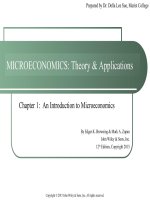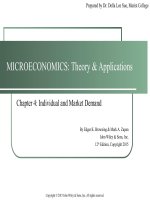Cost management accounting and control 6e by hansen mowen guan chapter 09
Bạn đang xem bản rút gọn của tài liệu. Xem và tải ngay bản đầy đủ của tài liệu tại đây (3.66 MB, 35 trang )
COST MANAGEMENT
Accounting & Control
Hansen▪Mowen▪Guan
Chapter 9
Standard Costing: A
Functional-Based Control
Approach
COPYRIGHT © 2009 South-Western Publishing, a division of Cengage Learning.
Cengage Learning and South-Western are trademarks used herein under license.
1
Study Objectives
1. Describe how unit input standards are developed, and
explain why standard costing systems are adopted.
2. Explain the purpose of a standard cost sheet.
3. Compute and journalize the direct materials and direct
labor variances, and explain how they are used for
control.
4. Compute overhead variances three different ways, and
explain overhead accounting.
5. Calculate mix and yield variances for direct materials
and direct labor.
2
Developing Unit Input Standards
• Unit standard cost is the product of
standard price and standard quantity
Standard Standard
�
Price
Quantity
SP �SQ
• Quantity standards specify how much of the
input should be used per unit of output
• Price standards specify how much should be
paid for the quantity of the input to be used
3
Developing Unit Input Standards
• Ideal standards demand maximum
efficiency and can be achieved only if
everything operates perfectly.
• Currently attainable standards can be
achieved under efficient operating
conditions.
• Kaizen standards reflect a planned
improvement and are a type of currently
attainable standard.
4
Developing Unit Input Standards
• Usage of standard costing systems
– Cost management
– Planning and control
– Decision making and product costing
5
Developing Unit Input Standards
6
Standard Cost Sheets
7
Variance Analysis and Accounting:
Direct Materials and Direct Labor
Total budget variance = (AP AQ) – (SP
SQ)
8
Variance Analysis and Accounting:
Direct Materials and Direct Labor
9
Variance Analysis and Accounting:
Direct Materials and Direct Labor
Accounting for the Direct Materials Price and
Usage Variances
10
Variance Analysis and Accounting:
Direct Materials and Direct Labor
• Direct materials price variances can be
computed at the point
– when the direct materials are issued into
production OR
.– when the materials are purchased
• This method would require AQ to be defined as the
actual quantity purchased, rather than actual
quantity used)
11
Variance Analysis and Accounting:
Direct Materials and Direct Labor
Direct materials usage variances should be computed as
direct materials are issued into production.
12
Variance Analysis and Accounting:
Direct Materials and Direct Labor
13
Variance Analysis and Accounting:
Direct Materials and Direct Labor
Accounting for the Direct Labor Rate
and Efficiency Variances
14
Variance Analysis and Accounting:
Direct Materials and Direct Labor
• Investigating direct materials and labor
variances
– Because random variations around the standard are
expected, management should establish an
acceptable range of performance.
– The acceptable range is the standard, plus or minus
an allowable deviation.
• The upper control limit is the standard plus the allowable
deviation
• The lower control limit is the standard minus the allowable
deviation.
15
Variance Analysis and Accounting:
Direct Materials and Direct Labor
Disposition of Direct Materials and
Direct Labor Variances Immaterial
16
Variance Analysis and Accounting:
Direct Materials and Direct Labor
Disposition of Direct Materials and
Direct Labor Variances Material
17
Variance Analysis: Overhead Costs
18
Variance Analysis: Overhead Costs
19
Variance Analysis: Overhead Costs
20
Variance Analysis: Overhead Costs
21
Variance Analysis: Overhead Costs
22
Variance Analysis: Overhead Costs
23
Variance Analysis: Overhead Costs
Accounting for Overhead Variances
24
Variance Analysis: Overhead Costs
Accounting for Overhead Variances
(continued)
25









